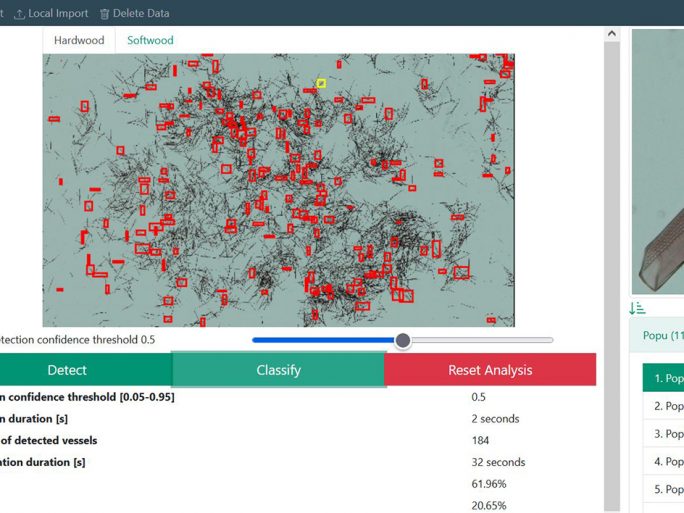AI in the Fight Against Deforestation

Anyone trading timber in the EU must submit samples. However, the inspection process is time-consuming. An image recognition AI is intended to ease this burden.
The fight against deforestation in the European Union has taken a significant step forward with the introduction of the European Deforestation Regulation (EUDR). This regulation aims to ensure that goods traded within the EU do not contribute to ongoing deforestation. As part of this effort, companies that trade in timber must now submit samples to verify the wood species used in their products. However, the inspection process is time-consuming and labor-intensive. To alleviate this burden, an AI-driven image recognition system is being developed to streamline the process.
The EUDR requires anyone placing timber products on the EU market to document the types of wood used and verify their legal origin. Yet, verifying these declarations is not always straightforward, especially for materials like paper, which require specialists to examine them in a lengthy process. To address this challenge, researchers at the Fraunhofer Institute for Industrial Mathematics ITWM, in collaboration with the Thünen Institute of Wood Research, are developing an AI-powered image recognition system that will simplify and accelerate the verification process.
Simplifying the Verification Process
The growing global demand for wood has led to an increase in illegal logging. To combat this, the EU introduced the Timber Regulation in 2013, the predecessor to the EUDR. Since then, companies have been required to document the wood types in their products and verify their legal origins. This applies to a wide range of wood products, including chipboard, fiberboard, paper, and cardboard. But identifying wood species in these products can be challenging.
Currently, wood product testing is conducted by experts at the Thünen Institute, a research organisation under the Federal Ministry of Food and Agriculture (BMEL). These experts receive numerous samples from the industry and government authorities for wood species testing—a task that is becoming increasingly demanding.
The testing process involves analysing samples under a microscope, which is time-consuming. For materials like paper and fiberboard, wood cells are extracted, stained, and prepared on microscope slides. Experts then classify these cells based on their appearance. Due to the complexity and length of this process, only a limited number of samples can be processed.
This is where the new AI analysis software comes in. It is designed to support and relieve highly qualified specialists, speeding up and automating the testing process. This will enable faster and more efficient inspections. The automated image recognition system, being developed as part of the KI_Wood-ID project, uses machine learning to identify wood species. The project, funded by the BMEL, is a collaboration between Fraunhofer ITWM and the Thünen Institute of Wood Research in Hamburg.
AI vs. Illegal Timber Trade
The KI_Wood-ID project initially focuses on identifying hardwoods, particularly plantation woods cultivated worldwide for pulp production. By analyzing vascular cells with varying structures, shapes, and sizes, the AI can determine the type of wood. Using reference specimens from the Thünen Institute’s extensive wood collection, researchers at Fraunhofer ITWM train neural networks to recognise and classify the distinct features of different wood species, enabling the AI to identify the species in a microscopic image of an unknown sample.
Each wood species, such as birch, beech, or poplar, is trained individually. The AI analysis software first highlights the cells essential for identifying the wood species in the images. “The sample is flagged if it contains features that don’t match the declared wood species,” explains Dr. Henrike Stephani, project manager of KI_Wood-ID and deputy head of the Image Processing department at Fraunhofer ITWM in Kaiserslautern.
The primary goal of this AI software is to strengthen the legal wood trade and protect consumers. Certain wood species, like Ramin, enjoy special protection. Ramin forests are crucial habitats for orangutans in regions like Borneo. “A few years ago, wood chips of this species were sent to the Thünen Institute for identification, after being collected by Greenpeace at an Asian pulp mill storage site,” recalls Dr. Stephani. “If protected species like Ramin are processed into pulp and then into paper, our method will be able to identify them in the final product, holding manufacturers accountable.”
Preventing Deforestation Globally
An initial prototype of the analysis system can already recognise eleven hardwood species, based on the references it has been trained with. The next phase will focus on identifying softwoods. The prototype, which features a graphical user interface, is currently available to the Thünen Institute. However, the long-term goal is for AI-based image recognition to support testing laboratories and authorities worldwide in monitoring the international timber trade. “Ultimately, deforestation and the illegal timber trade can only be effectively tackled on a global scale. We hope that our system will benefit globally recognised testing organisations in the future,” says Dr. Stephani.